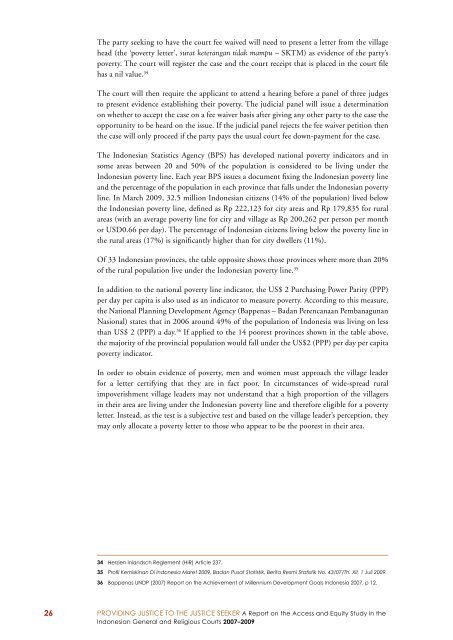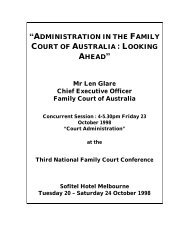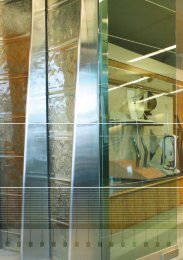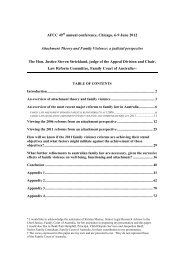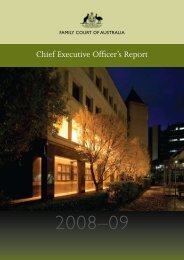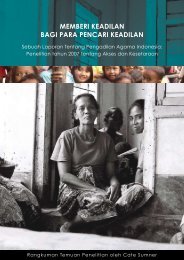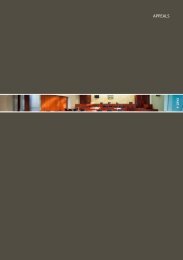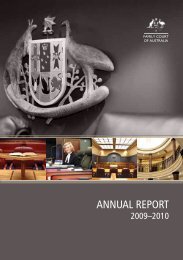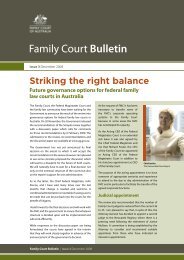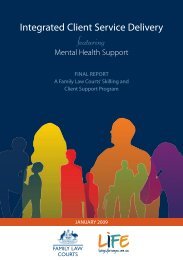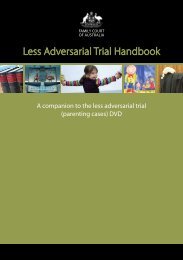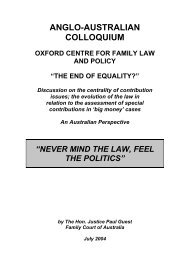Providing Justice to the Justice Seeker: - Family Court of Australia
Providing Justice to the Justice Seeker: - Family Court of Australia
Providing Justice to the Justice Seeker: - Family Court of Australia
- No tags were found...
Create successful ePaper yourself
Turn your PDF publications into a flip-book with our unique Google optimized e-Paper software.
The party seeking <strong>to</strong> have <strong>the</strong> court fee waived will need <strong>to</strong> present a letter from <strong>the</strong> villagehead (<strong>the</strong> ‘poverty letter’, surat keterangan tidak mampu – SKTM) as evidence <strong>of</strong> <strong>the</strong> party’spoverty. The court will register <strong>the</strong> case and <strong>the</strong> court receipt that is placed in <strong>the</strong> court filehas a nil value. 34The court will <strong>the</strong>n require <strong>the</strong> applicant <strong>to</strong> attend a hearing before a panel <strong>of</strong> three judges<strong>to</strong> present evidence establishing <strong>the</strong>ir poverty. The judicial panel will issue a determinationon whe<strong>the</strong>r <strong>to</strong> accept <strong>the</strong> case on a fee waiver basis after giving any o<strong>the</strong>r party <strong>to</strong> <strong>the</strong> case <strong>the</strong>opportunity <strong>to</strong> be heard on <strong>the</strong> issue. If <strong>the</strong> judicial panel rejects <strong>the</strong> fee waiver petition <strong>the</strong>n<strong>the</strong> case will only proceed if <strong>the</strong> party pays <strong>the</strong> usual court fee down-payment for <strong>the</strong> case.The Indonesian Statistics Agency (BPS) has developed national poverty indica<strong>to</strong>rs and insome areas between 20 and 50% <strong>of</strong> <strong>the</strong> population is considered <strong>to</strong> be living under <strong>the</strong>Indonesian poverty line. Each year BPS issues a document fixing <strong>the</strong> Indonesian poverty lineand <strong>the</strong> percentage <strong>of</strong> <strong>the</strong> population in each province that falls under <strong>the</strong> Indonesian povertyline. In March 2009, 32.5 million Indonesian citizens (14% <strong>of</strong> <strong>the</strong> population) lived below<strong>the</strong> Indonesian poverty line, defined as Rp 222,123 for city areas and Rp 179,835 for ruralareas (with an average poverty line for city and village as Rp 200,262 per person per monthor USD0.66 per day). The percentage <strong>of</strong> Indonesian citizens living below <strong>the</strong> poverty line in<strong>the</strong> rural areas (17%) is significantly higher than for city dwellers (11%).Of 33 Indonesian provinces, <strong>the</strong> table opposite shows those provinces where more than 20%<strong>of</strong> <strong>the</strong> rural population live under <strong>the</strong> Indonesian poverty line. 35In addition <strong>to</strong> <strong>the</strong> national poverty line indica<strong>to</strong>r, <strong>the</strong> US$ 2 Purchasing Power Parity (PPP)per day per capita is also used as an indica<strong>to</strong>r <strong>to</strong> measure poverty. According <strong>to</strong> this measure,<strong>the</strong> National Planning Development Agency (Bappenas – Badan Perencanaan PembanagunanNasional) states that in 2006 around 49% <strong>of</strong> <strong>the</strong> population <strong>of</strong> Indonesia was living on lessthan US$ 2 (PPP) a day. 36 If applied <strong>to</strong> <strong>the</strong> 14 poorest provinces shown in <strong>the</strong> table above,<strong>the</strong> majority <strong>of</strong> <strong>the</strong> provincial population would fall under <strong>the</strong> US$2 (PPP) per day per capitapoverty indica<strong>to</strong>r.In order <strong>to</strong> obtain evidence <strong>of</strong> poverty, men and women must approach <strong>the</strong> village leaderfor a letter certifying that <strong>the</strong>y are in fact poor. In circumstances <strong>of</strong> wide-spread ruralimpoverishment village leaders may not understand that a high proportion <strong>of</strong> <strong>the</strong> villagersin <strong>the</strong>ir area are living under <strong>the</strong> Indonesian poverty line and <strong>the</strong>refore eligible for a povertyletter. Instead, as <strong>the</strong> test is a subjective test and based on <strong>the</strong> village leader’s perception, <strong>the</strong>ymay only allocate a poverty letter <strong>to</strong> those who appear <strong>to</strong> be <strong>the</strong> poorest in <strong>the</strong>ir area.34 Herzien Inlandsch Reglement (HIR) Article 237.35 Pr<strong>of</strong>il Kemiskinan Di Indonesia Maret 2009, Badan Pusat Statistik, Berita Resmi Statistik No. 43/07/Th. XII, 1 Juli 2009.36 Bappenas UNDP (2007) Report on <strong>the</strong> Achievement <strong>of</strong> Millennium Development Goals Indonesia 2007, p 12.26 <strong>Providing</strong> <strong>Justice</strong> <strong>to</strong> <strong>the</strong> <strong>Justice</strong> <strong>Seeker</strong> A Report on <strong>the</strong> Access and Equity Study in <strong>the</strong>Indonesian General and Religious <strong>Court</strong>s 2007–2009


